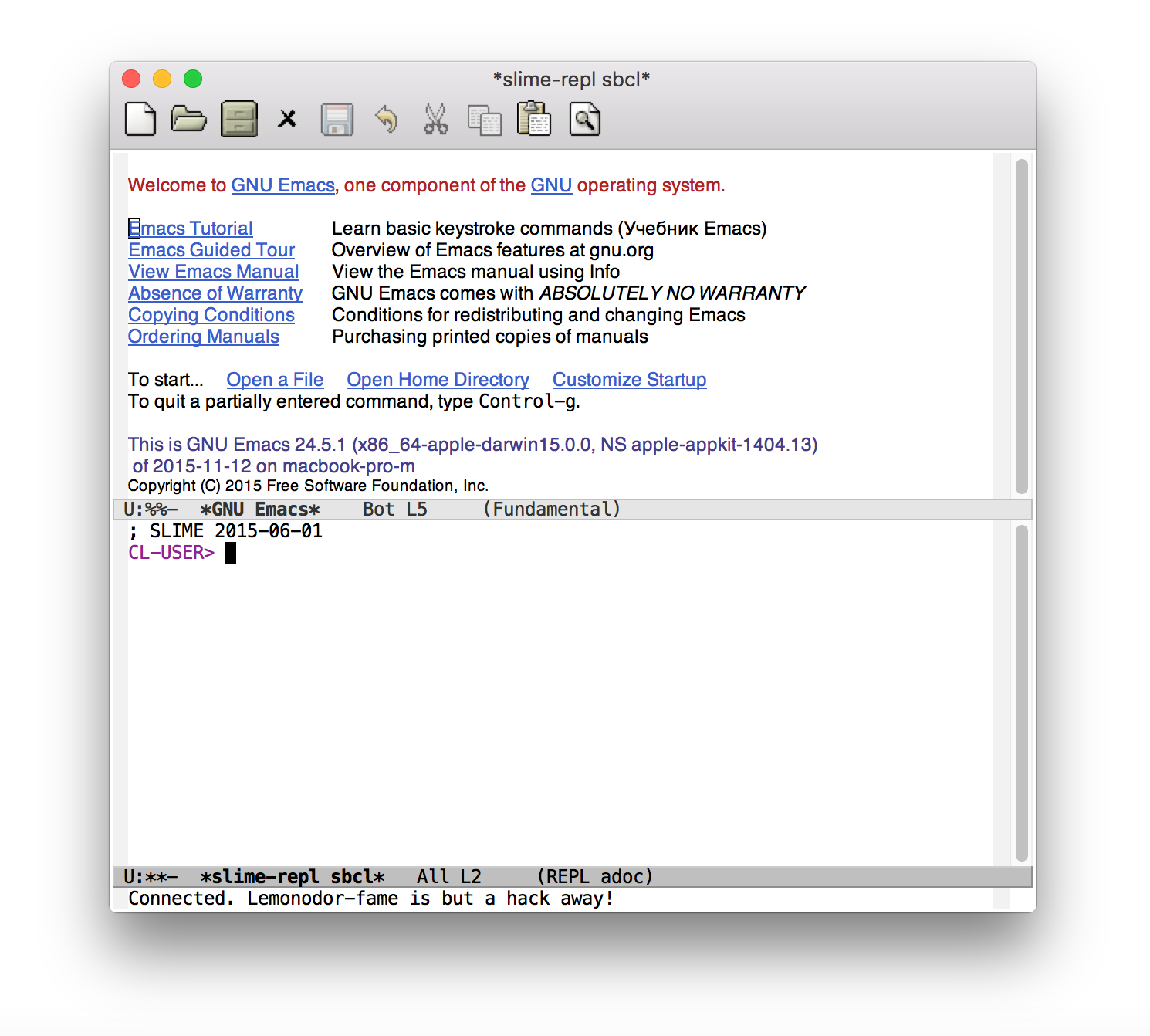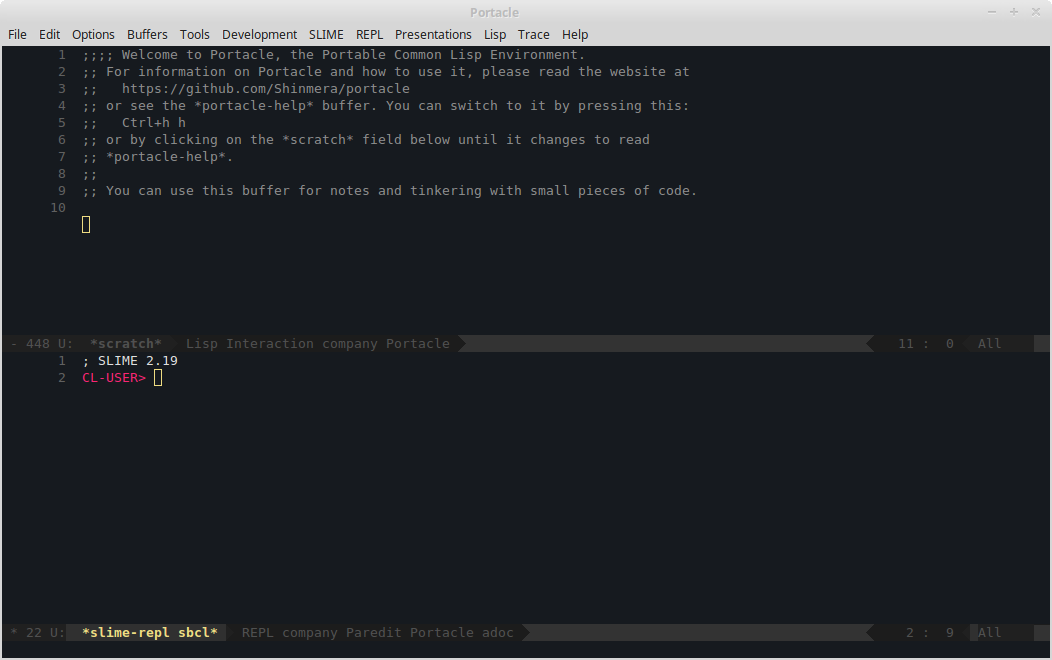Lisp for iOS, Android, and OS X. Creating mobile applications shouldn't require you to do everything in Java and Objective-C. With mocl, you can put your application logic into a shared Lisp library that runs on iOS, Android, and even OS X. Furthermore, since mocl runs an expansive subset of Common Lisp, an ANSI standard like C, you can also. Lispbox test builds. To get Lispbox, simply download and extract the distribution for your platform. No installation required! Start Lispbox by running lispbox.bat (Windows) / lispbox.sh (Linux) / Emacs (OS X).
A copy of GNU Emacs 22 without GUI support compiled in is available on all recent versions of Mac OS X via the shell. However, there are other Emacs distributions geared towards Mac OS X that include GUI support as well as other distinctions that may make it a more appropriate choice for some.
Macintosh Common Lisp (MCL) is an implementation and IDE for the Common Lispprogramming language. Various versions of MCL run under the classic Mac OS (m68k and PPC) and Mac OS X.
Versions of MCL up to and including 5.1 are proprietary. Version 5.2 has been open sourced.
In 2009 a new different version of MCL has been open sourced: RMCL.[1] RMCL is based on MCL 5.1 and does run under Rosetta on Intel-based Macs.

Features of MCL[edit]


MCL was famous for its integration with the Macintosh toolbox (later: Apple Carbon), which allowed direct access to most of the Mac OS functionality directly from Lisp. This was achieved with a low-level interface that allowed direct manipulation of native Mac OS data structures from Lisp, together with a high-level interface that was more convenient to use.
In a 2001 article in Dr. Dobb's Journal, Peter Norvig wrote that 'MCL is my favorite IDE on the Macintosh platform for any language and is a serious rival to those on other platforms'.[2]
History of MCL[edit]
Development on MCL began in 1984.
Over its history, MCL has been known under different names:
Running on 68k-based Apple Macintosh Computers:
- 1987, Coral Common Lisp
- 1987, Macintosh Allegro Common Lisp
- 1988, Apple Macintosh Common Lisp
Running on PowerPC-based Apple Macintosh Computers:
- 1994, Digitool Macintosh Common Lisp
It has also spawned at least one separately maintained fork:
- 1998, Clozure CL (CCL), known previously as OpenMCL
- In 2007 MCL 5.2 was open sourced.
- In 2009 RMCL (MCL running under Rosetta) was published as open source.
- Since 2009 an open source version of RMCL (based on MCL 5.2) is hosted at Google Code MCL. This version runs under Rosetta (Apple's PPC to Intel code translator that is an optional install under Mac OS X 10.6).
References[edit]
External links[edit]
- MCL 5.2 (sources and binary).
- RMCL[permanent dead link] (sources and binary).
- Mac Common Lisp at NIST
I’ve been a Lisp nut for years. I was first exposed to Lisp on my TRS-80, when I was about thirteen; Randy Beer had written a Lisp introduction in the March ’83 issue of 80 Micro, and I remember reading it again and again. I’ve used various flavors of Lisp for exploratory prototyping programming over the years, and have enjoyed using both Scheme and Common Lisp.
Getting a dialect of Common Lisp running on Mac OS X isn’t hard — in fact, if you’re just setting out, an excellent choice is LispWorks Personal Edition. I’ve recently gotten to the point, however, where I’ve wanted to do some work with the Common Lisp Interface Manager, which isn’t supported in LispWorks Personal Edition under Mac OS X, and set out to configure a Common Lisp installation on my MacBook from the ground up.
It wasn’t difficult, although it took some Googling to get all the pieces together; shortly after I finished, someone on the Bay Area Functional Programmer‘s mailing list asked about running Common Lisp on Mac OS X, and I put together my notes on the topic and replied. The list is fairly small — less than 300 members — and I promised them and myself that I’d organize the notes and provide them in a more accessible location.
What follows is a step-by-step installation guide to installing Steel Bank Common Lisp (SBCL) and McCLIM on a PowerBook G4; I undertook this from the initial notes I took configuring the MacBook. I chose SBCL because it’s well-supported by the open source community and works well with McCLIM; I have nothing against other Common Lisp implementations, including Clozure.Â
A word of warning is in order: I’m comfortable with Common Lisp, but relatively unfamiliar with how Common Lisp programmers handle package distribution. I get the basic idea behind ASDF, of course, but I’m not seasoned in its use. Consequently, I had a get-things-working-and-clean-up-later mentality when I undertook my first SBCL-McCLIM configuration, and this largely remained when I wrote what follows. Other Lisp developers may have better ways to organize their working environments, and I’d welcome positive comments (drop me an email, and we’ll figure out how to incorporate your feedback).
Starting out, you should have a relatively up-to-date Mac OS X box (I’ve done this on Mac OS X 10.4.x and 10.5.x systems). When you’re done, you will have installed Carbon Emacs, SLIME, SBCL, and McCLIMÂ configured to work with the X Windows server Mac OS X provides, along with darcs.Â
Carbon Emacs
Carbon Emacs on Mac OS X provides you with an Emacs instance running as a Mac OS X application. I like it for general editing, as well as the obvious purpose of giving me a place to run SLIME and do my Lisp development.
- Get Carbon Emacs from its home page. If you need a version for a version of Mac OS X other than 10.5, check here.
- Mount the disk image you download, and copy Emacs.app to your Applications folder.
Steel Bank Common Lisp
- Download SBCL. Choose either X or P on this page for the X86 or PPC build, respectively.
- Unpack the distribution, and open a Terminal to the directory where you’ve unpacked the distribution.
- Install per the INSTALL instructions. I used the default options, placing SBCL in /usr/local by issuing:
Cubase torrent download. At this point in time, you should be able to run SBCL from the shell.
SLIME
SLIME in Carbon Emacs is swell.
- Download SLIME. I used CVS in the terminal, stashing the whole thing in a hidden directory. If you use a lot of emacs packages, you may well already have a directory for them, and you can put SLIME there as well.
- Wire SLIME up to your emacs installation. I followed the instructions in the SLIME documentation.
In a nutshell, it says to add the following to your ~/.emacs:Â Â Â Âwhere
/usr/local/bin/sbcl is the path to SBCL you specified in the previous section, and
~/.slime is the path to the slime directory you specified in the previous step.
You can stop at this point if you don’t want to work with McCLIM; you have a working SBCL
environment using Carbon Emacs and SLIME. To use SLIME, start emacs from the Terminal or
Carbon Emacs and run SLIME using M-x slime.

darcs

Some of the stuff you need for McCLIM is kept in a darcs repository, so you first need to get and install darcs. I used one of the pre-built binaries. Make sure that however you do this, darcs is in your path when you’re done installing, of course.
Â
McCLIM
I followed these steps  to build and configure McCLIM from source.
Lisp For Mac Os X
- You’re going to use ASDF to get various Common Lisp packages, and you need a place to put the resulting files, as well as to tell SBCL where that place is. Make a directory ~/lispsystems in your home directory, and configure SBCL by adding the following to your ~/.sbclrc file:
- Fetch the McCLIM sources.
- Fetch McCLIM’s dependencies: the Common Lisp Library for X, spatial-trees, and flexichain:
- Build the McCLIM system. Fire up Carbon Emacs, run SLIME using M-x slime, and enter:
Be prepared to wait a while as the system builds for the first time.Â
- To see if everything works as expected, you can build the samples:
- To play with the samples:
You also have the option of getting McCLIM using clbuild, as this page describes. That worked for me under Mac OS X 10.5, but did not under Mac OS X 10.4, and I didn’t bother to investigate what was different.Â
Mac Os Update
Good luck and happy hacking!
